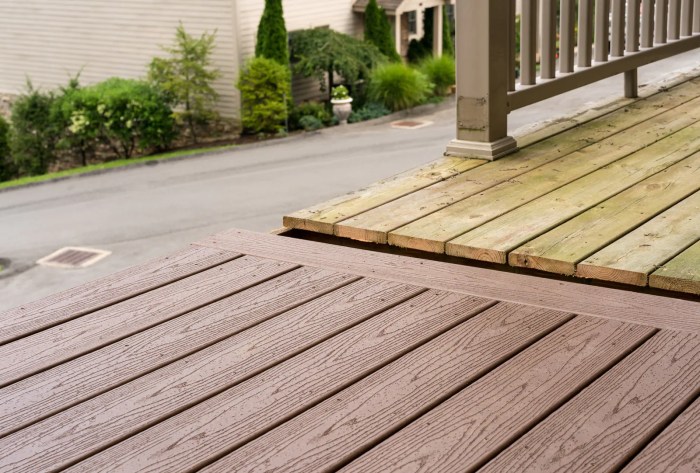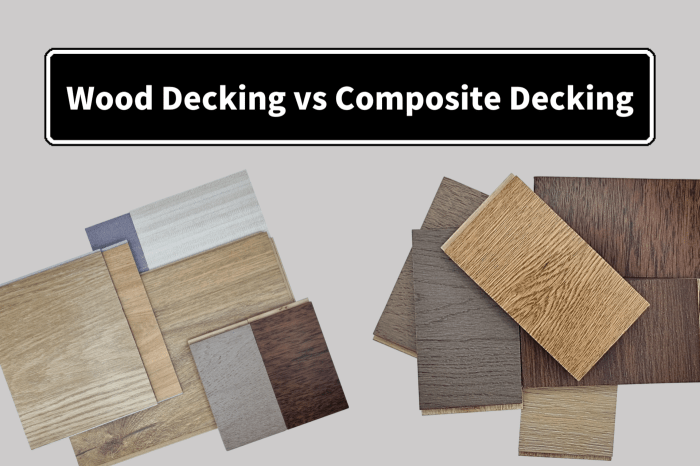Composite vs Wood Decking: A Comprehensive Comparison

Exploring the world of composite vs wood decking, this article delves into the differences between these popular materials used for outdoor spaces. From durability to aesthetics, get ready to uncover the pros and cons of each option.
Introduction to Composite and Wood Decking
When it comes to building a deck, one of the key decisions to make is choosing between composite and wood decking materials. Both options have their own set of benefits and drawbacks, so it's important to understand the differences between them.
Composite Decking Materials
Composite decking is made from a combination of wood fibers, plastic, and binding agents. This material is known for being durable, low-maintenance, and resistant to rotting, warping, and splintering. It also comes in a variety of colors and styles to suit different aesthetic preferences.
Wood Decking Materials
Wood decking, on the other hand, is typically made from pressure-treated lumber or hardwoods like cedar, redwood, or tropical hardwoods. While wood decking has a natural look and feel, it requires more maintenance, such as regular staining, sealing, and waterproofing to prevent decay and insect damage.
Brief History of Composite vs Wood Decking
The debate between composite and wood decking has been ongoing for many years. In the past, wood decking was the traditional choice due to its natural appearance and affordability. However, as technology has advanced, composite decking has become increasingly popular for its durability and low-maintenance properties.
Material Composition

Composite decking is made up of a blend of wood fibers, plastic, and a binding agent. The wood fibers can come from a variety of sources, including recycled wood products, while the plastic component is often made from recycled materials such as plastic bags or bottles.
The binding agent holds everything together and helps create a durable, long-lasting material that mimics the look of real wood.
Composition of Composite Decking
Composite decking typically consists of:
- Wood fibers
- Recycled plastic
- Binding agent
Composition of Wood Decking
Wood decking, on the other hand, is made entirely of natural wood. Different species of wood can be used, each with its unique characteristics and durability. Common types of wood used for decking include cedar, redwood, and pressure-treated pine.
Durability Comparison
When it comes to durability, composite decking tends to outperform wood decking. Composite materials are resistant to rot, mold, and pests, making them a low-maintenance option. Wood decking, while beautiful, requires more maintenance to prevent rot, warping, and insect damage.
However, with proper care and maintenance, wood decking can also last for many years.
Installation Process
When it comes to installing decking, whether it's composite or wood, there are specific steps to follow to ensure a successful outcome. Below, we will detail the installation process for both composite decking and wood decking, as well as discuss the tools required for the job.
Composite Decking Installation
Composite decking is known for its durability and low maintenance requirements. The installation process for composite decking typically involves the following steps:
- Prepare the substructure: Ensure the existing deck frame is structurally sound and level before installing composite boards.
- Start with the perimeter: Begin by installing composite boards around the perimeter of the deck, securing them with appropriate fasteners.
- Install the inner boards: Once the perimeter boards are in place, proceed to install the inner composite boards, leaving a small gap between each board for expansion.
- Secure the boards: Use recommended screws or clips to secure the composite boards to the deck frame, ensuring they are evenly spaced and aligned.
- Finish with trim: Complete the installation by adding trim boards around the edges of the deck for a polished look.
Wood Decking Installation
Wood decking, while a classic choice, requires more maintenance compared to composite decking. The installation process for wood decking involves the following steps:
- Prepare the substructure: Similar to composite decking, make sure the deck frame is sturdy and level before installing wood planks.
- Lay the first plank: Start by laying the first wood plank perpendicular to the deck joists, ensuring proper spacing between boards.
- Continue with additional planks: Proceed to install the remaining wood planks parallel to the first one, securing them with nails or screws.
- Secure the boards: Use appropriate fasteners to secure the wood planks to the deck frame, making sure they are tightly fastened.
- Apply finish: Once all the wood planks are in place, consider applying a protective finish to enhance durability and longevity.
Tools Required for Installation
To successfully install both composite and wood decking, you will need the following tools:
- Power drill: Essential for drilling pilot holes and driving screws or nails into the deck boards.
- Measuring tape: To ensure accurate spacing and alignment of the decking boards.
- Saw: Whether a circular saw or a miter saw, you'll need it to cut the decking boards to the desired length.
- Level: To check the evenness of the deck surface during installation.
- Decking screws/nails: Necessary for securing the decking boards to the frame.
- Clips/fasteners (for composite decking): Specific fasteners designed for composite decking installation.
Maintenance Requirements
When it comes to maintaining your decking, whether it's composite or wood, there are specific requirements to keep in mind. Let's delve into the details of the maintenance needed for each material and compare the upkeep costs between composite and wood decking.
Maintenance for Composite Decking
Composite decking is known for being low maintenance compared to wood decking. Here are some key points to consider when maintaining composite decking:
- Regular cleaning with soap and water to prevent mold and mildew buildup.
- Avoid using harsh chemicals or pressure washers that can damage the surface.
- Periodic inspection for any damage or loose boards that need to be fixed.
- No need for staining, sealing, or painting like with wood decking.
Maintenance for Wood Decking
Wood decking requires more maintenance compared to composite decking. Here are some key points to consider when maintaining wood decking:
- Regular cleaning to prevent mold, mildew, and rotting of the wood.
- Staining or sealing every 1-3 years to protect the wood from the elements.
- Periodic sanding and refinishing to maintain the appearance and structural integrity.
- Replacement of damaged or rotting boards as needed.
Comparison of Upkeep Costs
When comparing the upkeep costs of composite and wood decking, it's essential to consider the long-term expenses involved.
- Composite decking generally has higher upfront costs but lower maintenance costs over time due to its durability and resistance to rot, mold, and insects.
- Wood decking may have lower initial costs, but ongoing maintenance expenses for staining, sealing, and repairs can add up over the years.
- Overall, composite decking tends to be more cost-effective in the long run, requiring less time and money for maintenance compared to wood decking.
Environmental Impact

When it comes to the environmental impact of decking materials, both composite and wood options have their own set of considerations to take into account.
Composite Decking
Composite decking is often considered more eco-friendly than wood decking due to its use of recycled materials such as plastic and wood fibers. This helps reduce the demand for new resources and minimizes the amount of waste that ends up in landfills.
Additionally, composite decking does not require the use of harmful chemicals for maintenance, which can further contribute to a more sustainable choice.
Wood Decking
Wood decking, on the other hand, is a natural material that is biodegradable and renewable when sourced from sustainable forests. However, the harvesting and transportation of wood can have a significant impact on deforestation and carbon emissions. Additionally, wood decking often requires the use of chemical treatments to protect against rot, pests, and weathering, which can have negative environmental implications.
Sustainability
In terms of sustainability, composite decking has the edge over wood decking due to its use of recycled materials and reduced need for maintenance with harmful chemicals. However, it is important to consider the overall lifecycle of the product, including production, transportation, installation, and disposal, to truly assess its environmental impact.
Wood decking, when sourced from responsibly managed forests and treated with eco-friendly methods, can also be a sustainable choice for those looking to minimize their environmental footprint.
Aesthetics and Design Options
Composite and wood decking both offer unique aesthetic appeal and design options to suit different preferences.
Aesthetic Appeal of Composite Decking
Composite decking is known for its modern and sleek appearance. It often mimics the look of natural wood but comes in a wide range of colors and finishes. The uniformity of composite boards creates a clean and contemporary look that appeals to those seeking a low-maintenance and consistent design aesthetic.
Aesthetic Appeal of Wood Decking
Wood decking exudes a classic and timeless charm that many homeowners appreciate. The natural grain patterns and earthy tones of wood create a warm and inviting atmosphere in outdoor spaces. As wood ages, it develops a unique patina that adds character and charm to the deck, making it a popular choice for those who prefer a traditional and rustic look.
Design Options for Each Material
Composite decking
Available in a variety of colors, textures, and finishes, composite decking offers endless design possibilities. From contemporary to rustic, composite boards can be customized to suit different styles and preferences. Some composite decking brands even offer boards with unique patterns and inlays for a more personalized touch.
Wood decking
Wood decking provides a natural and organic feel to outdoor spaces. With different wood species like cedar, redwood, and pressure-treated pine, homeowners have the flexibility to choose a wood type that complements their home's architectural style. Additionally, wood decking can be stained or painted to achieve a specific color or finish, allowing for customization to match any design aesthetic.
End of Discussion

In conclusion, when it comes to choosing between composite and wood decking, it ultimately boils down to personal preference, budget, and maintenance capabilities. Both materials have their own unique benefits, so make sure to weigh your options carefully before making a decision.
FAQ Corner
Is composite decking more expensive than wood decking?
Composite decking tends to have a higher upfront cost compared to wood decking, but the maintenance costs over time are typically lower.
Which material is more eco-friendly, composite or wood decking?
Composite decking is generally considered more eco-friendly as it is often made from recycled materials and does not require chemical treatments like wood decking.
What tools are needed for installing wood decking?
Common tools for installing wood decking include a hammer, drill, tape measure, level, and saw.

